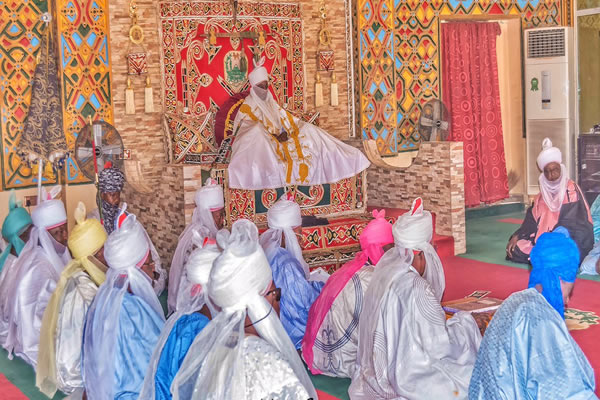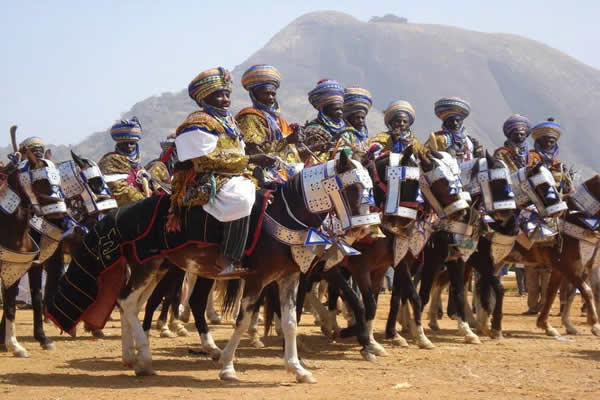
INTRODUCTION
Kano State is a state located in North-Western Nigeria. Created on May 27, 1967 from part of the Northern Region, Kano state borders Katsina State to the north-west, Jigawa State to the north-east, and Bauchi and Kaduna states to the south. The capital of Kano State is Kano.Kano State is the second largest industrial center in Nigeria and the largest in Northern Nigeria with textile, tanning, footwear, cosmetics, plastics, enamelware, pharmaceuticals, ceramics, furniture and other industries. Others include agricultural implements, soft drinks, food and beverages, dairy products, vegetable oil, animal feeds etc.
HISTORY
The Hausa Kingdom of Kano was based on an ancient settlement of Dalla Hill. While small chiefdoms were previously present in the area, according to the Kano Chronicle, Bagauda, a grandson of the mythical hero Bayajidda,. became the first king of Kano in 999, reigning until 1063. Muhammad Rumfa ascended to the throne in 1463 and reigned until 1499.

During his reign he reformed the city, expanded the Sahelian Gidan Rumfa (Emir's Palace), and played a role in the further Islamization of the city as he urged prominent residents to convert. The Hausa state remained independent until the Fulani conquest of 1805.
At the beginning of the 19th century, Fulani Islamic leader Usman dan Fodio led a jihad affecting much of northern Nigeria, leading to the emergence of the Sokoto Caliphate. Kano became the largest and most prosperous province of the empire. This was one of the last major slave societies, with high percentages of enslaved population long after the Atlantic slave trade had been cut off.
Heinrich Barth, a classical scholar who spent several years in northern Nigeria in the 1850s, estimated the percentage of slaves in Kano to be at least 50%, most of whom lived in slave villages.
The Kano Chronicle stated that the Kingdom of Kano was founded as one of the Seven True Hausa States or Hausa Bakwai by Baguada in 999. Bagauda was a grandson of Abuyazidu (Bayajda), who was acknowledged by legend to be the origin of the Hausa people. During the rule of King Gajemasu from 1095 to 1134, the kingdom’s capital was transferred from Sheme towards the current location.In 1340s, Islam was introduced to Kano by Malinke scholars, who originated from Mali Empire. Yaji, who ruled from 1349 to 1385, may have been the first Muslim king of Hausa. The religion Islam got the blame for Kano’s loss against Zaria around 1400 and it was relinquished by King Kanajeji.
People & Culture

According to the 2016 PON census (unofficial) figures from Nigeria Kano State had a population totaling 9,383,682. Officially, Kano State is the most populous state in the country. The state is mostly populated by Hausa people.
The official language of Kano State is Hausa language, but Fulani languages is commonly spoken.
Geography
Kano State of the Federal Republic of Nigeria lies between latitude 130N in the North and 110N in the South and longitude 80W in the West and 100E in the East. Kano State is made up of the following forty four local government areas: Ajingi, Albasu, Bagwai, Bebeji, Bichi, Bunkure, Dala, Dambatta, Dawakin Kudu, Dawakin Tofa, Doguwa, Gabasawa, Garko, Garun Mallam, Gaya, Gezawa, Gwale, Gwarzo, Kabo, Karaye, Kibiya, Kiru, Kumbotso, Kura, Kunchi, Madobi, Makoda, Minjibir, Kano Municipal, Nassarawa, Rimin Gado, Rogo, Shanono, Sumaila, Takai, Tarauni, Tsanyawa, Tudun Wada, Tofa, Warawa and Wudil. The total land area of Kano State is 20,760sq kilometers with a population of 9,383,682 (2006 provisional result). Some Local Government areas of Jigawa State were part of Kano Emirate before the creation of that state. The people of Kano State who have no other hometown call themselves Kanawa.Kano City has been the capital of Kano State since the earliest recorded time. It is located on latitude 12.000N and longitude 8.300E within the semi-arid Sudan savannah zone of West Africa about 840 kilometers from the edge of the Sahara desert. Kano has a mean height of about 472.45m above sea level.
Kano City has expanded over the years and has become the third largest conurbation in Nigeria; it had a population of 1,412,255 when the last population census was conducted in 1991. It is made up of six local government areas: Municipal, Gwale, Dala, Tarauni, Nassarawa and Fagge. Kano's most enduring legacy Gidan Rumfa (Emir's Palace) the seat of Kano's prestigious Sarauta institution (Kingship) built over five hundred years ago is located in the Municipal Local Government Area. The Kano State Government House is located in Tarauni Local Government Area.

Climate
The temperature of Kano usually ranges between a maximum of 330C and a minimum of 15.80C although sometimes during the harmattan it falls down to as low as 100C. Kano has two seasonal periods, which consist of four to five months of wet season and a long dry season lasting from October to April. The movement of the South West maritime air masses originating from the Atlantic Ocean, influences the wet season which starts from May and ends in September. The commencement and length of wet season varies between northern and southern parts of Kano State. The length of the season in Riruwai, which is southern part of Kano State is six months from early May to late September. While in northern parts it is from June to early September.The average rainfall is between 63.3mm + 48.2mm in May and 133.4mm + 59mm in August the wettest month. The movement of the tropical maritime air masses from the Southwest to the North determines the weather of Kano State during the wet season. This air mass carries a lot of moisture from over the Atlantic Ocean. This moisture condenses when it is forced to rise by convection or over a barrier of highlands or an air mass; it then falls back as rain. The period of the heights occurs when the sun passes over West Africa between March and June.
The dry season starts in October and lasts till about April of the following year. Temperatures are low during this period because the sun is in the Southern Hemisphere and because of movement of the desiccating continental air mass, which originates from the Sahara area and blows from the Northeast carrying along with it the harmattan dust. This is also the harvesting season.

Vegetation
The vegetation of Kano State is the semi-arid savannah. The Sudan Savannah is sandwiched by the Sahel Savannah in the north and the Guinea Savannah in the south. The savannah has been described as the zone that provides opportunity for optimal human attainment. This is because it is rich in faunal and floral resources, it is suitable for both cereal agriculture and livestock rearing, and the environment is relatively easy for movement of natural resources and manufactured goods (Connah 1987: 97-99).The canopies of the trees are very wide and most of them are less than 20m tall. The following are the common trees of Kano State: Acacia albida (Hausa: gawo), Acacia nilotica (Hausa: gabaruwa), baobab Adanosia digitata (Hausa: kuka), Anogeissus leiocarpus (Hausa: marke), neem Azadirachta indica (Hausa: dogon yaro), desert date Balanties aegyptica (Hausa aduwa), ebony Diospyros mespiliformis (Hausa: kanya), mahogany Khaya senegalensis (Hausa: madachi), locust bean Parkia clappertoniana (Hausa: dorawa), Piliostigma thonningii (Hausa: kargo), Sclerocarya birrea (Hausa: danya), Vitex doniana (Hausa: dinya), Ziziphus spina-christi (Hausa: kurna) (Nichol 1988). These trees are very resistant to drought.
It has been suggested that these products have been available as part of the vegetable resources in the West African savannah for two to three thousand years. Domesticated crops include sorghum, millet and African rice, several indigenous yams, two African groundnuts, cowpeas and black beniseed (Connah 1987:101).
The natural vegetation of Kano State has been modified as result of several centuries of human activities such as bush clearing and burning for cultivation and hunting as well as animal grazing.
Emergency Numbers (08101589562, 08033369129)
Banks in Kano
Brief History of Kano
Business and Economy
Festivals and Carnivals
General and Teaching Hospitals
Hotels and Guest Houses
Local Governments & LCDAs
Kano State Ministries Agencies and Parastatals
Police Stations
Popular Markets
Prominent Towns
Restaurants, Bars, Night Clubs
Shopping Malls
Kano State Executive Council
Tourist Attractions
Traditional Rulers
Banks in Kano
Brief History of Kano
Business and Economy
Festivals and Carnivals
General and Teaching Hospitals
Hotels and Guest Houses
Local Governments & LCDAs
Kano State Ministries Agencies and Parastatals
Police Stations
Popular Markets
Prominent Towns
Restaurants, Bars, Night Clubs
Shopping Malls
Kano State Executive Council
Tourist Attractions
Traditional Rulers




